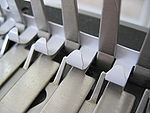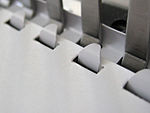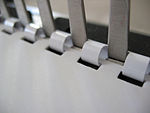- Comb binding
-
Spine capacity Inches Millimeters Sheets of paper 3/16" 4mm 16 1/4" 6mm 25 5/16" 8mm 40 3/8" 10mm 55 7/16" 11mm 70 1/2" 12mm 85 9/16" 14mm 100 5/8" 16mm 125 3/4" 20mm 150 7/8" 22mm 175 1" 25mm 200 1⅛" 28mm 250 1¼" 32mm 275 1½" 38mm 325 1¾" 45mm 375 2" 51mm 425 Comb binding (sometimes referred to as "cerlox binding") is one of many ways to bind pages together into a book. This method utilizes round plastic spines with 19 rings (for US Letter size) or 21 rings (for A4 size) and a hole puncher that makes rectangular holes. Comb binding is sometimes referred to as plastic comb binding or spiral comb binding.
Binding process
To bind a document, the user first punches holes in the paper with a specialized hole punch. Pages must be punched a few at a time with most of these machines. If hard covers are desired, they must be punched as well. In bulk applications, a paper drilling machine may be used.
Then the user chooses a spine size that will match the document. Standard sizes are 3/16 inch (for 10 sheets of 20# paper) up to 2 inches (for 425 sheets). Spine lengths are generally 11 inches to match the length of letter-size paper.
The rings on the spine open and insert into the holes in the page, then rest against the body of the spine, resulting in a closure that can be opened again for making changes to the book.
Comparison with other punch binds
With this bind, the book lies flat but cannot be opened 360 degrees. For a book that can be opened such that the covers touch, a spine that does not have an obstructive body, such as a coil binding, is a better option.
Machine opening the spine Pre-punched paper with spine rings through holes Rings closed on paper Completed book out of machine References
Categories:
Wikimedia Foundation. 2010.





